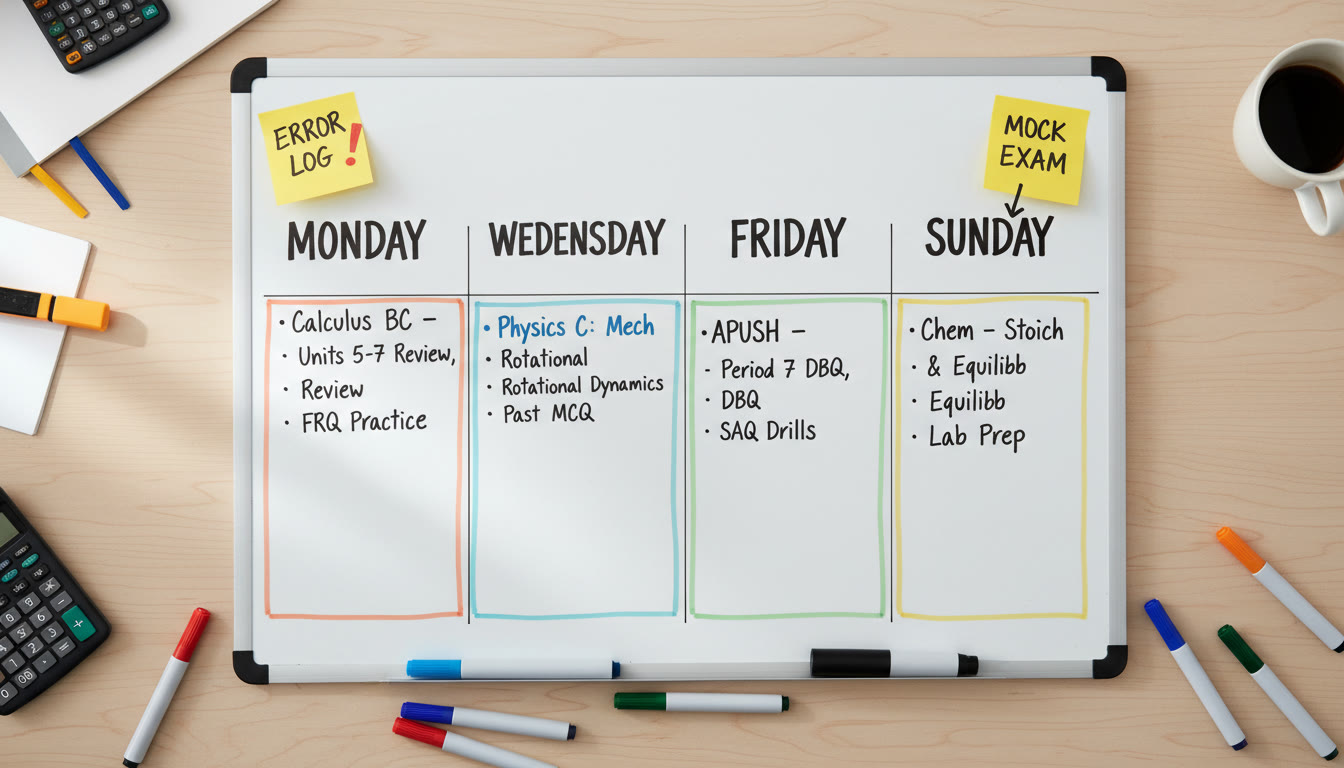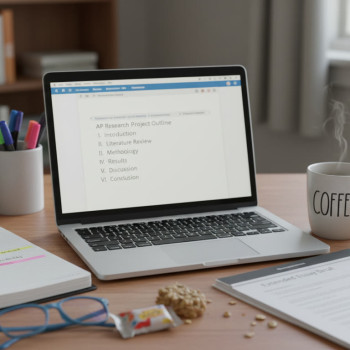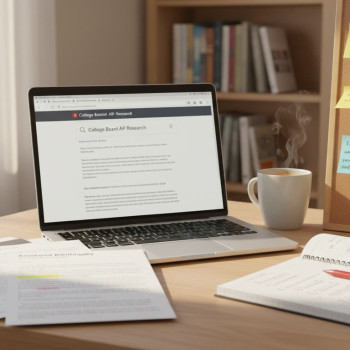Why a Problem-Set Rhythm Beats Random Practice
If you’re taking AP Calculus, AP Physics, AP Chemistry, or any other AP STEM course, you probably already know that doing lots of problems matters. But raw volume alone isn’t the secret sauce. What separates steady improvement from spinning your wheels is rhythm: a consciously designed pattern of practice that mixes new problem introduction, targeted review, low-stakes assessment, and reflection.
This post will help you craft a realistic, evidence-friendly problem-set rhythm planner you can use across AP STEM courses. You’ll get weekly and monthly templates, example session structures, a sample schedule table, and practical tips for staying motivated. You’ll also see where 1-on-1 help—like Sparkl’s personalized tutoring—fits naturally to accelerate weak-point repair and tailor study plans to your exact needs.

Start With Why: The Science Behind Spaced, Varied, and Active Practice
Before we dive into schedules, a quick reminder of the learning principles that make a problem-set rhythm work:
- Spaced practice: Revisiting topics at increasing intervals helps move skills from short-term to long-term memory.
- Interleaving: Mixing problem types (e.g., kinematics problems with energy problems) forces you to select methods rather than repeat routines—this builds transferable problem-solving skill.
- Active retrieval: Practicing recall (trying a problem from memory, then checking) is far more powerful than passive reviewing of notes.
- Feedback loops: Timely feedback—self-checks, solution comparisons, or tutor review—lets you correct misconceptions before they fossilize.
These ideas are universal for AP STEM courses: how you apply them depends on the subject and where you are in your term or AP calendar.
Design Principles for Your Planner
1. Keep Weekly Cadence Predictable but Flexible
Pick a weekly structure you can realistically repeat. Here’s a simple cadence that many students find sustainable:
- Monday — Concept Review + 3 Short Problems
- Wednesday — Focused Problem Set (timed, 45–75 minutes)
- Friday — Mixed Review + Weak-Point Drills
- Weekend — Cumulative Practice and Reflection (longer, lower-pressure session)
That’s four minimalist touchpoints; you can scale up or down based on course load. The key is that each session has a purpose: introduce, apply, diagnose, and consolidate.
2. Cycle Intensity: Micro, Meso, Macro
Think in three time scales:
- Micro (single session): Warm-up, focused problems, quick reflection.
- Meso (weekly): One heavy practice day, two maintenance days, one cumulative review.
- Macro (monthly/term): A mock exam or big timed set to simulate test conditions and inform adjustments.
Rotate topics through these cycles. For example, in AP Chemistry, one week’s heavy session could be equilibrium problems; the next month revisit equilibrium as part of a cumulative mock.
Weekly Template You Can Copy
Below is a practical weekly template you can adapt for AP Calculus AB/BC, AP Physics 1/2/C, or AP Chemistry. Times are suggestions; adjust to fit your schedule.
| Day | Session Type | Focus | Duration | Outcome |
|---|---|---|---|---|
| Monday | Concept Refresh | Key definitions, equations, 3 warm-up problems | 30–45 min | Identify uncertain elements |
| Wednesday | Deep Practice | Timed problem set on single topic | 60–90 min | Master common methods |
| Friday | Targeted Drills | 3–5 small problems on weak points | 30–50 min | Reduce error types |
| Saturday or Sunday | Cumulative Review | Mixed problems; low-pressure timed practice | 90–120 min | Reinforce retention |
How to Pick Problems for Each Session
Not all problems are equal. Use this quick rubric:
- Intro problems: Concept-checks and scaffolded examples.
- Core problems: Typical exam-style questions that exercise method selection.
- Stretch problems: Hard, multi-step questions that integrate concepts.
- Error-spotting: Problems designed to expose common misconceptions (e.g., sign mistakes in physics, stoichiometry slips in chemistry).
Monthly Rhythm and Mock Exams
Once a month, simulate a mini-exam: take a timed section or several problems back-to-back under exam conditions, then spend a full session reviewing every mistake. Use the results to reshape the next month’s drills—prioritize the units and skills where error rates were highest.
Make sure your monthly check-ins include:
- Timed practice for pacing
- One full error log review
- Re-sequencing your next month’s problem topics based on persistent gaps
Example: A 6-Week Plan for AP Physics 1
Below is a compact example showing how to rotate topics and problem types so you steadily gain fluency without burning out. This sample assumes you’re midway in the school year and have foundational exposure to the topics.
| Week | Primary Topic | Deep Practice Day | Weak-Point Drill | Weekend Review |
|---|---|---|---|---|
| 1 | Kinematics | Motion graphs and projectile problems | Vector decomposition drills | Mixed kinematics set (timed) |
| 2 | Dynamics | Forces, free-body diagrams | Normal vs. friction errors | Mini mock integrating kinematics + dynamics |
| 3 | Work and Energy | Energy conservation and work problems | Units and sign errors | Mixed conservation problems |
| 4 | Momentum | Collisions and impulse | Center-of-mass concept drills | Cumulative practice |
| 5 | Rotational Motion | Torque and rotational energy | Sign and axis mistakes | Timed mixed problems |
| 6 | Mock Exam Week | Timed section A + review | Targeted drills on high-error topics | Full reflection & re-plan |
How to Track Progress: The Error Log
Create a simple error log where every mistake gets recorded as soon as you review solutions. Each entry should include:
- Date and topic
- Type of error (concept, algebra, arithmetic, misread question)
- Correction step (what you’ll do differently next time)
- Follow-up date (when to re-test that skill)
Over time, patterns reveal themselves—maybe you lose points to algebra in Calculus problems, or you consistently mix up gas laws in Chemistry. Use those patterns to create micro-goals for your problem-set rhythm (e.g., three algebra-targeted drills every week for two months).
Practical Session Templates: What to Do Minute-by-Minute
30–45 Minute Session (Quick Touch)
- 5 minutes: Warm-up—skim notes and write down 3 key formulas from memory.
- 25–30 minutes: 3–4 practice problems (mix of difficulty). Time the harder one.
- 5–10 minutes: Check solutions; add mistakes to your error log.
60–90 Minute Session (Deep Practice)
- 10 minutes: Activate prior knowledge—list relevant concepts and relations aloud or in writing.
- 45–60 minutes: Timed problem set (5–8 problems) with a mix of core and stretch items.
- 15–20 minutes: Detailed review—rework mistakes and summarize strategies.
Using Resources Smartly (Textbooks, AP Classroom, and Tutors)
Not all resources are equal. Pair high-quality questions with targeted explanations and active review. If you’re using College Board materials and AP Classroom resources, align your weekly practice with the course unit weighting and skills your teacher emphasizes. When you hit a stubborn gap, consider short bursts of 1-on-1 tutoring; tailored guidance (for example, Sparkl’s personalized tutoring) can provide a focused explanation, re-sequence practice problems for maximum returns, and deliver AI-driven insights into error patterns that conventional study sometimes misses.
Sample Problem Bank Distribution by Difficulty
When assembling your own problem sets, aim for a pyramid distribution: most problems should be at or slightly above your comfort level, with a handful of stretch questions.
| Difficulty | Percent of Set | Purpose |
|---|---|---|
| Warm / Core | 60% | Build fluency and check foundational skills |
| Application | 30% | One- or two-step problems integrating ideas |
| Stretch | 10% | Complex, multi-concept problems to extend thinking |
Pacing Tips for the AP Exam
Practice pacing early. Simulate timed sections so you don’t discover timing issues on test day. For example, if you’re preparing for AP Calculus AB, practice 45–55 minute blocks for free-response problems and refine how long you allocate per part. Timing is a skill—work on it like any other.
Motivation and Burnout Management
Doing problems consistently is a long game. Here are a few psychological tricks that help:
- Micro-goals: Small wins every session—finish a stretch problem, correct a recurring error—create dopamine loops that keep you engaged.
- Accountability: Share your weekly rhythm with a friend or tutor. Scheduled Sparkl tutoring sessions, for example, can anchor your weekly practice and provide immediate feedback so you don’t plateau.
- Variety: Swap problem types or topics to keep curiosity alive and reduce monotony.
- Recharge windows: Build intentional downtime after longer study sessions to avoid cognitive exhaustion.
When to Seek 1-on-1 Help—and How to Use It Well
Private tutoring is most effective when it’s surgical: use it to fix recurring misconceptions, break through plateaus, or build a customized problem-sequencing strategy. A few targeted sessions can recalibrate your planner and give you new tools for self-correction.
How to make tutoring efficient:
- Bring a recent error log and mock-exam results so your tutor can diagnose patterns fast.
- Set clear, measurable goals for each session (e.g., “Reduce algebra errors in free-response by practicing five substitution problems and two multi-step integrals”).
- Ask your tutor to assign specific follow-up problems and a re-test date inside your rhythm planner.
Personalized services like Sparkl’s tutoring combine expert tutors with tailored study plans and AI-driven insights—when used judiciously, they can amplify the returns from your independent problem work without taking away ownership of learning.
Real-World Examples: How Students Turn Rhythm into Results
Let’s look at two compressed stories of how rhythm worked for different learners:
- Case A — The Recovering Crammer: Sam was a last-minute crammer who relied on marathon study nights. Transitioning to a 4-day-per-week rhythm with weekly mock sections lowered stress and improved retention. Sam used focused error logs to turn algebra mistakes into stepwise processes and raised his practice exam score by over a letter grade in six weeks.
- Case B — The Steady Climber: Priya had steady homework completion but low exam confidence. She added monthly full-length mock exams and weekly targeted drills on weak items. With two Sparkl tutoring check-ins each month to refine pacing and problem-selection, Priya improved her timed-section accuracy and finished the year with consistent AP-style performance.
Checklist: Set Up Your First Month
- Choose your weekly cadence and block it in your calendar for the next four weeks.
- Create a simple error log (spreadsheet or notebook).
- Assemble a bank of 50–80 problems sorted by topic and difficulty.
- Plan one mock session every 3–4 weeks and schedule review time immediately after.
- Schedule at least one targeted 1-on-1 session if you have persistent errors; bring the error log.
Final Notes: Consistency, Not Perfection
AP STEM mastery is a marathon of steady, intentional practice—one that values a predictable rhythm over bursts of frantic work. Problem sets are not just daily chores; they’re diagnostic tools that, when sequenced wisely, reveal strength and expose the places you can improve fastest.
Make your rhythm your routine: plan predictable practice, record the evidence of your mistakes, and build monthly simulations that force you to apply skills under pressure. Use targeted tutoring when you need surgical fixes or a personalized plan—one-on-one guidance, like Sparkl’s tailored tutoring and AI insights, can compress months of trial-and-error into a few focused sessions.

Ready to draft your first rhythm? Start small: plan one week right now, add one new habit to your session (error logging, timing, or reflection), and build from there. The habits you form in the next month will shape how you perform on exam day—steady practice plus smart feedback beats last-minute luck every time.
Happy problem solving—and remember, rhythm turns effort into progress.
















No Comments
Leave a comment Cancel